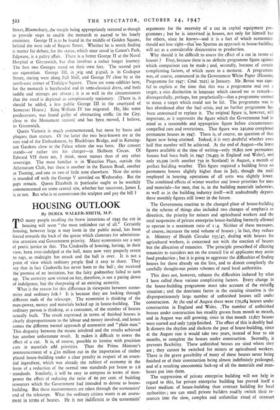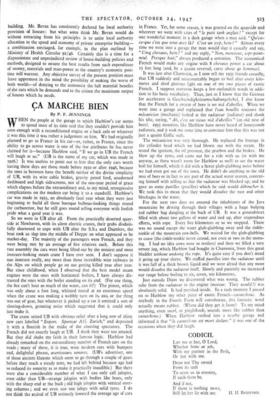HOUSING OUTLOOK
By DEREK WALKER-SMITH, M.P.
T. many people recalling the brave intentions of 1945 the cut in housing will seem " the most unkindest cut of all." Certainly housing, however large it may loom in the public mind, has been forced towards the back of the queue which clamours for administra- tive attention and Government priority. Many economists see a sort of poetic justice in this. The Cinderella of housing, having, in their
view, been over-indulged at the ball, must now very properly revert to rags, as midnight has struck and the ball is over. It is not a point of view which ordinary people find it easy to share. They say that in fact Cinderella has never been to the ball ; she received the'promise of an invitation, but the fairy godmother failed to turn up. The austerity nowvisited on her, therefore, is not a paring down of indulgence, but the sharpening of an existing austerity.
What is the reason for this difference in viewpoint between econo- mists and ordinary folk ? It is because they are looking through different ends of the telescope. The economist is thinking of the man-power, money and materials locked up in house-building. The ordinary person is thinking, as a consumer, of the number of houses actually built. The result expressed in terms of finished houses is clearly disproportionate to the labour and money involved, and hence comes the different mental approach of economist and " plain man." This disparity between the means involved and the results achieved has another unfortunate result. It makes it difficult to assess the effect of a cut. It is, of course, possible to itemise with precision cuts in materials mid priorities. Thus the Prime Minister's annnouncement of a LI o million cut in the importation of timber placed house-building under a clear penalty in respect of an essen- tial ingredient, which was already the subject of economy in the form of a reduction of the normal two standards per house to
standards. Similarly, it will be easy to compute in terms of man- power the effect of reducing the ratio of 6o per cent. of building resources which the Government had intended to devote to house- building. But these measurements are taken through the economists' end of the telescope. What the ordinary citizen wants is an assess- ment in terms of houses. He is not indifferent to the economists'
arguments for the necessity of a cut in capital equipment pro- grammes ; but he is interested in houses, not only for himself but for others, since he knows—and it is a fact of which economists should not lose sight—that too Spartan an approach to house-building will act as a considerable disincentive to production.
Why should it be difficult to assess the effect of a cut in terms of houses ? First, because there is no definite programme figure against which comparison can be made ; and, secondly, because of certain complicating factors, of which more in a moment. A programme was, of course, announced in the Government White Paper (Housing Programme for 1947: Cmd. 7021) in January. Mr. Bevan was care- ful to explain at the time that this was a programme and not a target, a nice distinction in language which caused me to remark— disrespectfully, perhaps, but prophetically—that a programme seemed to mean a target which could not be hit. The programme was in fact abandoned after the fuel crisis, and no further programme has been announced to replace it. The original figure is, however, still important, as it represents the figure which the Government had in mind as a reasonable and appropriate figure before circumstances compelled cuts and restrictions. That figure was 240,000 completed permanent houses in 1947. There is, of course, no question of that figure now being attained. Indeed, it is very doubtful whether even half that number will be achieved. At the end of August—the latest figures available at the time of writing—only 76,805 new permanent houses had been built in 1947 (7o,493 in England and Wales), and only 10,509 (with another 75o in Scotland) in August, a month of perfect building weather. This figure required a building force on permanent houses slightly higher than in July, 'though the total employed in housing operations of all sorts was slightly lower. The combined effects of winter weather and lower priorities for men and materials—for men,. that is, in the building materials industries, as well as in the building industry itself—will undoubtedly depress these monthly figures still lower in the future.
The Government reaction to the changed place 'of house-building in the scheme of things also included two changes of emphasis or direction, the priority for miners and agricultural workers and the total suspension of private enterprise house-building formerly allowed to operate in a maximum ratio of I :4. Neither of these measures, of course,. increases the total volume of houses ; in fact, they reduce it. Ministry of Health Circular 155/47, dealing with houses for agricultural workers, is concerned not with the erection of houses but the allocation of tenancies. The principle prescribed of allotting tenancies to outsiders not on the council list of applicants may assist food production ; but it is going to aggravate the difficulties of finding houses for those already on the lists, and to distort completely the carefully thought-out points schemes of rural local authorities.
This does not, however, exhaust the difficulties induced by what I have called these various complicating factors. Every change in the house-building programme must take account of the existing situation ; and the dominant factor in the existing situation is the disproportionately large number of unfinished houses still under construction. At the end of August there were 170,284 houses under construction in England and Wales. .The number of unfinished houses under construction has steadily grown from month to month, and in August was still growing, since in that month 12,827 houses were started and only 7,059 finished. The effect of this is doubly bed. It distorts the rhythm and slackens the pace of house-building, since at the August rate it would take two years, instead of four to six months, to complete the houses under construction. Secondly, it prevents flexibility. These unfinished houses are sited where they are ; they cannot be switched for miners or agricultural workers. There is the grave possibility of many of these houses never being finished or of their construction being almost indefinitely prolonged, and of a resulting uneconomic lock-up of all the materials and man- hours put into them.
The suppression of private enterprise building will not help in regard to this, for private enterprise building has proved itself a faster medium of house-building than contract building for local authorities ; nor can small private builders readily switch their re- sources into the slow, complex and unfamiliar ritual of contract
building. Mr. Bevan has consistently declared for local authority provision of houses: but what some think Mr. Bevan would do without retracting from his principles is to unite local authority allocation to the speed and economy of private enterprise building— a combination envisaged, for example, in the plan outlined by Ministry of Health Circular 92/46. Certainly this is a time for a dispassionate and unprejudiced review of house-building policies and methods, designed to ensure the best results from such expenditure of money, materials and man-power as the country's economic posi- tion will warrant. Any objective survey of the present position must leave uppermost in the mind the possibility of making the worst of both worlds—of denying to the economist the full material benefits of the cuts which he demands and to the citizen the maximum output of houses which he needs.

































 Previous page
Previous page